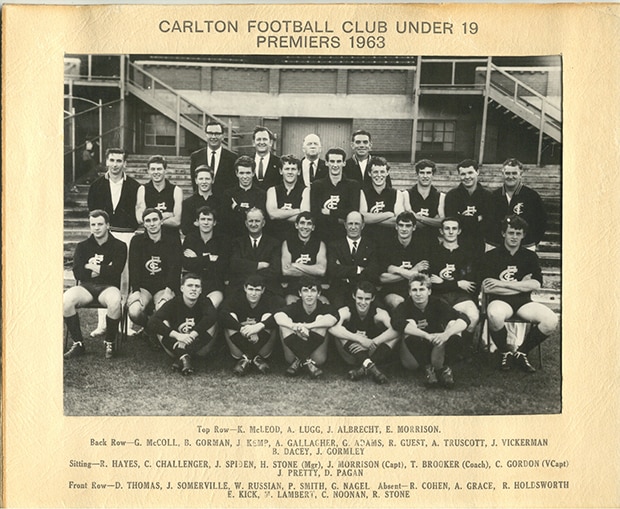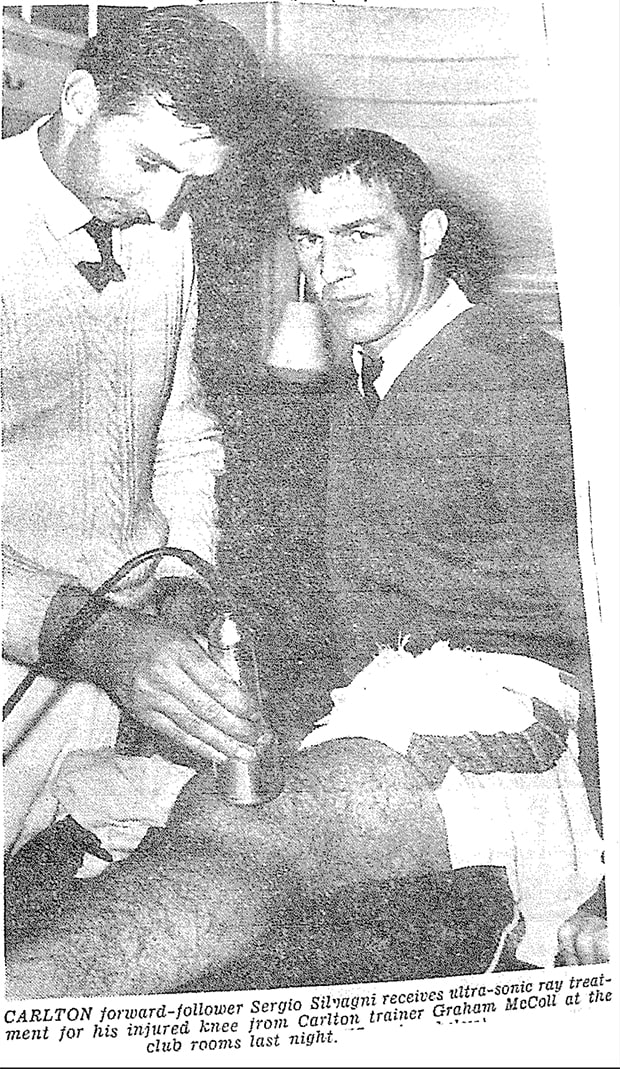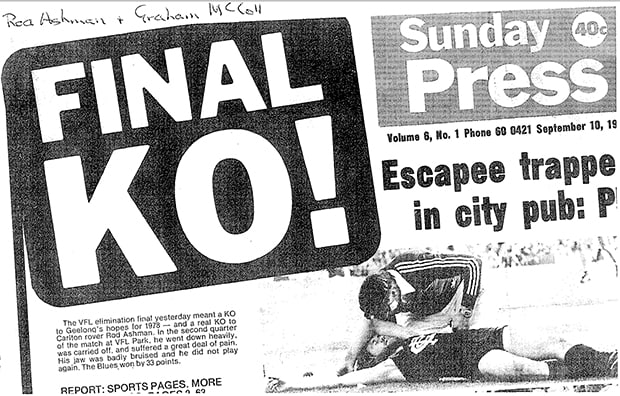It's almost 60 years since Graham McColl completed his senior debut for the Carlton Football Club. For McColl, the game against North Melbourne in the second round of 1958 would herald in an association that would endure for more than a quarter of a century at Princes Park - but not as he had anticipated.
Just 10 senior games into his maiden season, in the night grand final against St Kilda at the Lakeside Oval in September ’58, McColl ruptured the anterior cruciate in his right knee. Resuming training the following March, the young ruckman again broke down with the same injury. At 24, McColl’s League career was over before it had begun.

McColl is carried from Princes Park in a training mishap in March 1959. (Article by The Sun)
The proverbial silver lining came with McColl’s subsequent pursuit of recovery techniques – which in turn piqued his interest in becoming a club trainer. So it was that McColl embarked on his new career at Carlton, rising through the ranks of the support staff from thirds, to reserves and ultimately seniors.
In the premiership season of 1981, McColl’s contributions to Carlton as trainer were rewarded with Life Membership – the same year in which players Mark Maclure and Graeme Whitnall were similarly honoured.
Now 83, McColl recently penned the following reminiscences of his life and times at Carlton.
“Before I reminisce about my life to date as a player, member of the training staff, member of past players’ association and Life Member, it may be of help to give you some prior history of my football life with some details of how I became a Carlton player in 1958.
Early school years (commencing 1940) were at Wagga Wagga, New South Wales. I attended Forest Hill school, located outside the Aerodrome, on which I lived. I played Rugby and represented the school in athletics to year six.
After the War, we moved back to Melbourne and various parts of Victoria, which resulted in me attending many different schools. Eventually we moved to East Coburg where my parents obtained a home and my father was discharged from the R.A.A.F.
At this time I went to Preston Technical School and, after learning NOT to RUN with the ball under my arm (as in Rugby), I played in the school’s Australian Rules team, where we played against other Technical Schools in the metropolitan area and won many games. Ron Barassi (who later went to Melbourne) played as a half-forward flanker, and Brian Pert (later to play for Fitzroy) and myself were the wingmen.
I was invited to play for the Carlton Under 19s, however I wasn’t able to play a game, as family commitments forced me to look for a club in the vicinity and that’s how I came to play at Coburg in the VFA, playing 68 games. I feel my summer training with Preston Harriers and at Preston Tech., in running, high jump and hurdles, helped me with my ability to play in various positions if required.
1950s saw me as a telephone technician in training, working in many exchanges in Melbourne and country areas, and moving through various levels. With a transfer for eight weeks to Geelong Exchange, my father arranged for me to train at Geelong Football Club, with Reg Hickey as coach. I learnt a lot there and won Coburg Football Club’s Best & Fairest in 1956. Geelong asked me to sign a Form 4, however, Carlton was aware of this and claimed me as their player, where I played ten games in 1958 for the seniors. Of interest during this time was the payment the players received, which was 12 pounds for a full match and the Provident fund only being available after 50 games!
My first game was against North Melbourne, where I played as centre half-forward, my opponent being Albert Mantello. He tried me out physically and I more than held my own, with two goals. I also gave Mantello a hefty bump to which his teammate commented: ‘You’ve got one here, Albert’.
The night series at the South Melbourne ground saw me playing in the ruck, where I received my knee injury in a final against St Kilda. Medical staff didn’t know how serious my injury was. I drove home and went to work the next day. My boss sent me off to the local doctor and then to a physiotherapist. He didn’t know what the full extent of my injury was either. I missed the next year and so I wrote to the American National Football Association and received a strapping procedure – 30 strips of tape – but not much help.
When Dr. Arnold Cooper came to the club he explained what the problem was an I was offered a position on the training staff, with ongoing training by Dr. Cooper and our new physiotherapist Geoff Luke.
I was employed as a trainer for the Under 19s. In addition to looking after injured players, I became a messenger to players from the coach. Some of the players who started in the Under 19s were Adrian Gallagher, Jim Sullivan, Ray O’Halloran, Mark Maclure, John Morrison and Bruce Doull. The Under 19s won the premiership in 1963.

Trainer Graham McColl (middle row, far left) with members of Carlton’s under-19 premiership team of 1963, which includes Adrian Gallagher and Denis Pagan.
During my time as a trainer, the senior team won four Grand Finals in 1968, ’70, ’72 and ’79 – the latter in which Wayne Harmes (a local boy with a ‘never-say-die’ attitude) saved the ball on the boundary to enable Ken Sheldon to kick the winning goal. This is still a matter of discussion for Collingwood supporters. Alex Jesaulenko captained and coached his grand final team, but we had to carry him off with a serious ankle injury. However, with true spirit, he was there to receive the premiership cup at the end of the game.

McColl tends to Sergio Silvagni's knee in 1966.
Back in the ’70s, a VFL Trainers’ Association was established by a couple of Hawthorn trainers. The association established a training scheme for those persons who wanted to become members of their club’s medical team and be present on the ground during games. Interested parties were required to participate in a six to 12-week practical course, which involved resuscitation and different methods of strapping. The course was conducted at the Collingwood ground.
As the years rolled on, my employment with Telecom caused me, at one stage, to resign my position with the senior XVIII staff. I was able to overcome this, as management moved me to a position that enabled me to attend training sessions during the week. Later, I was offered the position of Head Trainer, but had to decline as my work for Telecom would not allow me to be at the ground for commencement of training and in time for strapping.

McColl to the rescue of Rod Ashman, elimination final vs. Geelong, VFL Park, September 1978.
On a brighter note, I enjoyed assisting those who were new to the club, the camaraderie and the interaction between training staff and players was excellent, even though we were all on various levels. Sunday morning recovery sessions consisted of lap running, hot and cold showers and rubdowns and a drink of some description to finish off. On many occasions, players, trainers and staff got together with wives and girlfriends, sometimes not getting home until mid-afternoon.
I tended to lose my interest when we basically became ‘waterboys’. However, nowadays the players have doctors, physios and mini-ambulances available to get them to more specialised treatments – and they sure need it with the game edging towards a Rugby format. I’ve always known the game as Australian Rules football (but there’s a) number of ball-ups (scrums), handling the ball incorrectly (throwing) and running the ball down the ground before kicking or shooting for goal (basketball). Umpires should also be able to assess that players are required to bounce the ball within 10-20 metres of running, or otherwise be penalised. I feel the umpires need to be re-trained in these areas.
Overall, I have enjoyed my time with Carlton. In writing these reminiscences, it has brought back some wonderful memories, of trips away, pride in winning Premierships and watching new players develop their skills.
Thanks for your interest in my time at Carlton, and to finish – Go Blues!”
Graham McColl (No.36)



